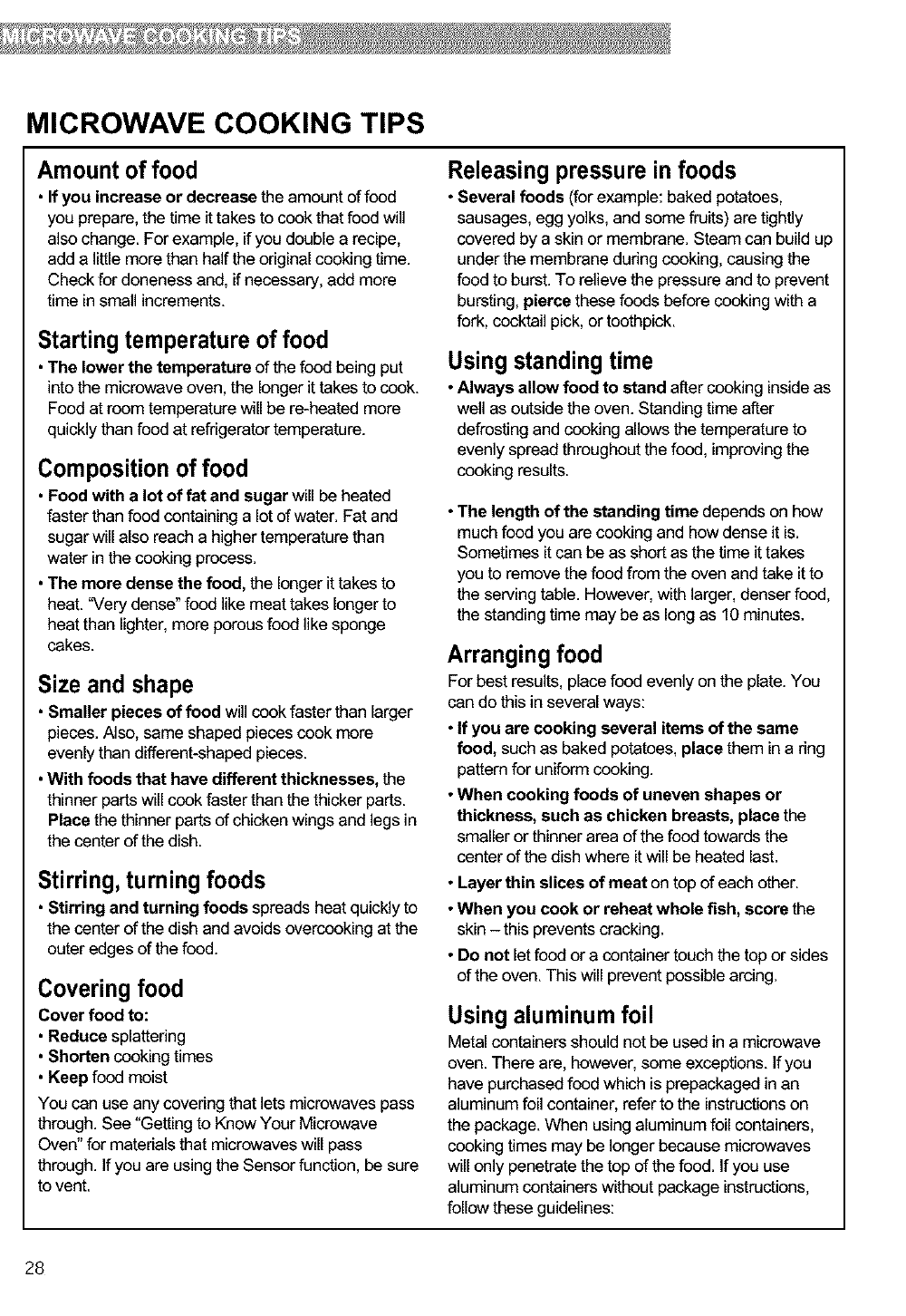
MICROWAVE COOKING TIPS
Amount of food
• Ifyou increase or decrease theamountoffood
you prepare,the time ittakes to cook that food will
also change. For example, ifyou double a recipe,
add a little more than half the original cooking time.
Check fordoneness and, if necessary,add more
time in small increments.
Starting temperature of food
• The lower the temperature of thefood beingput
intothe microwave oven, the longer it takesto cook.
Food at roomtemperature will be re-heated more
quicklythan food at refrigeratortemperature.
Composition of food
• Food with a lot of fat and sugarwill be heated
faster than food containing a lot of water. Fat and
sugarwill also reach a higher temperature than
water inthe cooking process.
• The more dense the food, the longer it takes to
heat. "Very dense"food likemeat takes longer to
heatthan lighter, moreporous food likesponge
cakes.
Size and shape
• Smaller pieces of food willcookfaster than larger
pieces.Also, same shaped pieces cook more
evenly than different-shaped pieces.
•With foods that have differentthicknesses, the
thinner partswill cook faster than thethicker parts.
Place the thinner parts of chickenwings and legsin
the canter of the dish.
Stirring, turning foods
• Stirring and turning foods spreadsheatquicklyto
the canter of the dish and avoids overcooking at the
outeredges of the food.
Covering food
Coverfood to:
• Reduce splattering
• Shorten cooking times
• Keep food moist
You can use any covering that lets microwaves pass
through. See "Getting to Mow Your Microwave
Oven" for materials that microwaveswill pass
through. If you are using the Sensor function, be sure
to vent,
Releasing pressure in foods
• Several foods (forexample:baked potatoes,
sausages, eggyolks,andsome fruits) aretightly
coveredby a skin ormembrane. Steam can build up
under the membrane during cooking, causing the
foodto burst. To relieve the pressure and to prevent
bursting,pierce these foods beforecooking with a
fork,cocktail pick, or toothpick.
Using standing time
• Always allow food to stand aftercooking insideas
well asoutside the oven. Standingtime after
defrostingand cooking allows the temperature to
evenly spreadthroughout the food, improvingthe
cooking results.
• The length of the standing time depends on how
much food you are cooking and how dense it is.
Sometimes itcan be as short as the time it takes
youto remove thefood from the oven and take it to
the serving table. However, with larger, denser food,
the standing time may be as long as 10 minutes.
Arranging food
Forbest results, placefood evenly on the plate.You
can do this in several ways:
• If you are cooking several items of the same
food, such as baked potatoes, place them ina ring
pattern for uniform cooking.
• When cooking foods of uneven shapes or
thickness, such as chicken breasts, place the
smaller or thinner areaof thefood towards the
center of thedish where it willbe heated last.
• Layer thin slices of meat on top of eachother.
• When you cook or reheat whole fish, score the
skin - this preventscracking.
• Do not letfood or a container touch the top or sides
ofthe oven. This will prevent possiblearcing.
Using aluminum foil
Metal containersshould not be used in a microwave
oven. There are, however, some exceptions. Ifyou
have purchased food which is prepackaged in an
aluminum foil container, refer to the instructionson
the package. When using aluminum foil containers,
cooking times may be longer because microwaves
will only penetrate thetop of the food. Ifyou use
aluminum containers without package instructions,
follow these guidelines:
28


















